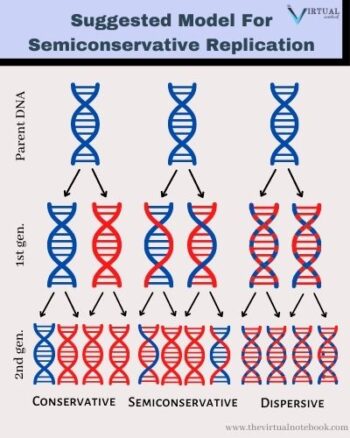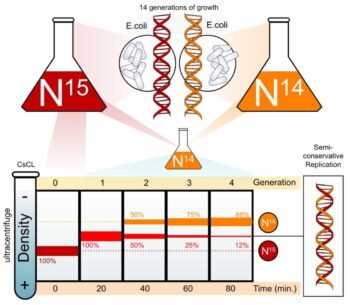In this article. we will learn about various models of DNA replication and how and why DNA replication is semiconservative.
DNA Replication Summary
One of the most important concepts of DNA replication is that it is a semiconservative process. In 1953, Watson and Crick proposed the three-dimensional structure of DNA. After five weeks, they published other important papers describing a mechanism by which the double helix could replicate. They proposed that the two complementary strands of the double helix unwind and separate and that each strand guides the synthesis of a new complementary strand. The sequence of bases in each parental strand act as a template. The base-pairing restrictions within the double helix dictate the sequence of bases in the newly synthesized strand. For example, Adenine in the parent strand will serve as a template for thymine in the nascent complementary strand.
This mechanism of DNA replication is called semiconservative replication. This means that every double helix in the new generation of an organism consists of one complete “old” strand and one complete “new” strand wrapped around each other.
This is in contrast to the two other possible models of DNA replication, the conservative model, and the dispersive model. A conservative mechanism of replication proposes the entire double-stranded DNA molecule serves as a template for a whole new DNA molecule, and the original DNA molecule will remain fully conserve during replication. Thus, the new cell has one completely new double-helix and one completely old double-helix.
The dispersive model of replication posits a final product in which each double helix of DNA is a mixture of fragments of old and new DNA. In light of current knowledge, it is difficult to imagine a dispersive mechanism, but at the time, there were no mechanistic models at all. These models were tested by Meselson and Stahl, who labelled the DNA of bacteria across generations using isotopes of nitrogen. From the patterns of DNA labelling, Meselson and Stahl confirmed that DNA replication is semiconservative.
What is DNA Replication?
DNA Replication is the process by which a cell copies its DNA prior to cell division.
In humans, the synthesis of a new strand of DNA occurs at the rate of about 3000 nucleotides per minute. In bacteria, about 30,000 nucleotides are added to a nascent DNA chain per minute. E. coli actually replicates its DNA at a rate of 1000 nucleotides/second, with less than one error in a billion nucleotides.
Clearly, the cellular machinery responsible for DNA replication must work very fast, but, even more importantly, it must work with great accuracy. Indeed, the fidelity of DNA replication is amazing, with an average of only one mistake per billion nucleotides incorporated after synthesis and the correction of mistakes during and immediately after replication. Undoubtedly, replication is an essential function of the genetic material and must be executed precisely if genetic continuity between cells is to be maintained following cell division.
DNA Replication Enzymes
There are five main enzymes involve in DNA Replication. These are:
- Helicase: this class of enzymes is responsible for unwinding the double helix of DNA.
- Gyrase: it belongs to the class topoisomerase. It is a bacterial enzyme that catalyzes the breaking and rejoining of bonds linking adjacent nucleotides in circular DNA to generate supercoiled DNA helices.
- Primase: It is a type of RNA polymerase and catalyzes the synthesis of primer (short RNA segment).
- DNA Polymerase (I AND III): These enzymes copy DNA sequences by using one strand as a template. All DNA polymerases require a template strand and a primer, which is complementary to the template. In general, DNA polymerases cannot initiate the synthesis of new strands, but can only extend an existing DNA or RNA strand paired with a template strand.
- Ligase: They fill in the gaps between DNA strands
Theories proposed for nature of DNA replication
There are three possible models on the nature of DNA replication:
- DNA replication is conservative
- DNA Replication is semiconservative
- Dispersive theory of DNA replication
Let’s discuss what are these theories and which one is most accurate.
DNA replication is Conservative
In conservative replication, the entire double-stranded DNA molecule serves as a template for a whole
new molecule of DNA, and the original DNA molecule will remain fully conserve during replication.
Dispersive DNA replication
In dispersive replication, both nucleotide strands break down into fragments. These broken fragments serve as templates for the synthesis of new DNA fragments. Then somehow, they reassemble into two complete DNA molecules. In this model, each resulting DNA molecule is interspersed with fragments of old and new DNA. As a result, none of the original molecules is conserved.
DNA replication is Semiconservative
In this model, the nucleotide strands unwind and each serves as a template for a new DNA molecule. This means that every double helix in the new generation of an organism consists of one complete “old” strand and one complete “new” strand wrapped around each other.
These three models allow different predictions about the distribution of the original DNA and newly formed DNA after replication. With conservative replication, 50% of the molecules would consist of the original DNA and 50% would consist entirely of new DNA. After the second round of replication, 25% of the molecules would consist of original DNA and 75% would consist entirely of new DNA. With each additional round of replication, the proportion of molecules with new DNA would increase, although the number of molecules with original DNA remain constant.
While Dispersive replication would always produce hybrid molecules that contain some original and some new DNA, but the new DNA’s proportion would increase with each replication event. In contrast to semiconservative replication, it produces two hybrid molecules. Each of these molecules contains half original DNA and half new DNA. With each passing round, it produces more entirely new DNA molecules and fewer hybrid molecules.

DNA Replication Semiconservative Model
Matt Meselson and Franklin Stahl originally met in the summer of 1954, the year after Watson and Crick published their paper on the structure of DNA. Although the two researchers had different research interests, they became intrigued by the question of DNA replication and decided to team up and take a crack at determining the replication mechanism.
In 1958, Matthew Meselson and Franklin Stahl demonstrated that the chromosome of E. coli replicates semi-conservatively. Then, in 1962, John Cairns demonstrated that the E. coli chromosome was a single duplex of DNA. Together, the results presented by Cairns and Meselson and Stahl showed that DNA replicates in a semiconservative manner in E. coli.
The Meselson-Stahl experiment
They proposed that the two complementary strands of the double helix unwind and separate. In addition, each strand guides the synthesis of a new complementary strand.
- Meselson and Stahl grew E. coli cells for many generations in a medium in which the heavy isotope of nitrogen, 15N, had been substituted for the normal, light isotope, 14N. As we all know that the purine and pyrimidine bases in DNA contain nitrogen. Thus, the cells grown on 15N rich medium will have a greater DNA density than the cells grown on 14N containing medium. A “heavy” isotope of nitrogen, 15N contains one more neutron than the naturally occurring 14N isotope; thus, molecules containing 15N are denser than those containing 14N.
- After growing many generations in this medium, the nitrogenous bases of all E. coli DNA were labelled with a heavy isotope of 15N.
- At this point, Meselson and Stahl took a sample of these bacteria. After that, they switched the rest of the bacteria to the medium that contains only 14N.
- Similarly, they grew the bacteria onto this medium for many generations and collect the sample. DNA made after the switch would have to be made up of 14N, as this would have been the only nitrogen available for DNA synthesis. The DNA samples collected in step 3 are heavier than the DNA samples collected in step 4 (because15N is heavier than 14N).
- They, then, separate the different density molecules by using the equilibrium density-gradient centrifugation technique. This method separates molecules such as DNA into bands by spinning them at high speeds in the presence of another molecule, such as cesium chloride, that forms a density gradient from the top to the bottom of the spinning tube. Molecules of DNA will reach equilibrium when their density equals the density of the gradient medium. In this case,15N-DNA will reach this point at a position closer to the bottom of the tube than will 14N-DNA.

Final Result
In this experiment,15N labelled cells were transferred to 14N containing medium only. Thus, all “new” synthesis of DNA during replication contained only the “lighter” isotope of nitrogen. The time of transfer to the new medium was taken as time zero (t = 0).
At generation zero
It is the time just before the switch to 14N medium. They found that DNA from bacteria grown only on medium containing 15N produced a single band after centrifugation. This result made sense because the DNA should have contained only heavy 15N at that time.
At generation 1
DNA isolated after one generation (one round of DNA replication) also produced a single band after centrifugation. However, this band was higher, intermediate in density between the heavy 15N DNA and the light 14N DNA.
The intermediate band told Meselson and Stahl that the DNA molecules made in the first round of replication were a hybrid of light and heavy DNA. This result fits with the dispersive and semi-conservative models, but not with the conservative model (two distinct bands would appear). Thus, this mode may be rejected.
At generation 2
After two cell divisions, DNA samples showed two density bands—one intermediate band and one lighter band corresponding to the 14N position in the gradient.
At generation 3 and 4
Similar results occurred after a third-generation, except that the proportion of the lighter band increased, and the middle band faded. This was again consistent with the interpretation that DNA replication is semiconservative.
Thus, over 3 & 4 generations, we’d expect the hybrid band to become progressively fainter and the light band to become progressively stronger.
Sources
Genetics- A conceptual Aproach, fifth edition by Benjamin A. Pierce chapter 12: DNA replication and recombination
Concepts of Genetics, tenth edition by William S. Klug, Michael R. Cummings, Charlotte A. Spencer, Michael A. Palladino part 2, chapter 11: DNA replication and recombination
Principles of Genetics, sixth edition, by D. Peter Snustad and Michael J. Simmons, chapter10: Replication of DNA and Chromosomes